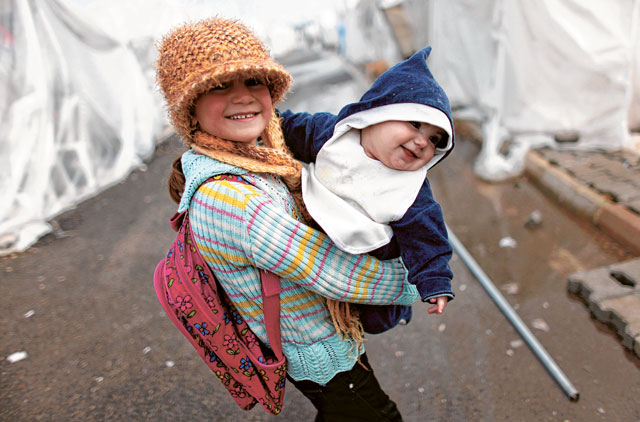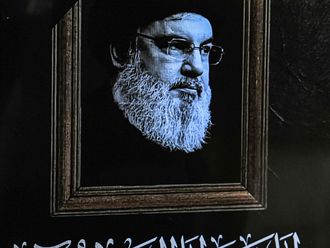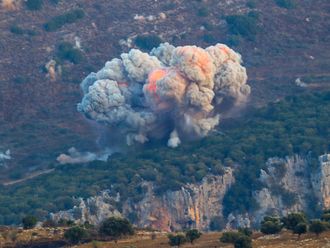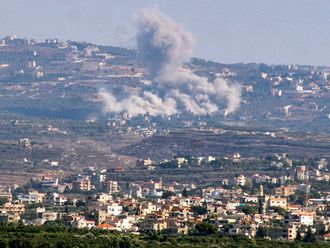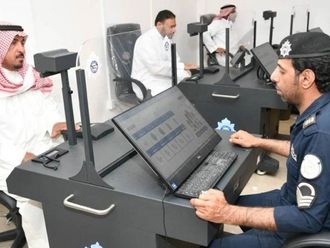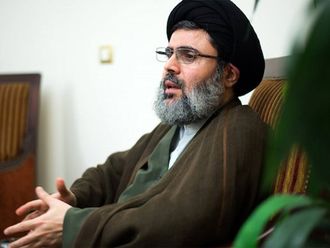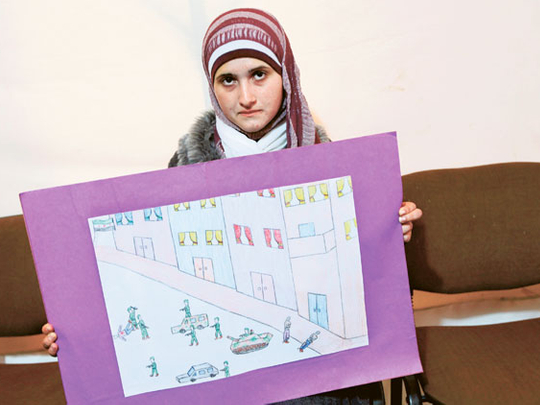
Boynuyogun, Turkey: A man lies on the street, bleeding from a gunshot wound to his chest, clutching a single red rose. In the foreground, a soldier fires a shot from the hatch of his tank, a red flame bursting from the barrel of his gun. A second man flails his arms as he too is shot in the chest.
On the street behind them stands a group of protesters, their faces expressionless. Two men hold placards inscribed in Arabic: "The people want the downfall of the regime", "Down with the traitor of the nation".
If a picture is worth a thousand words, then 14-year-old Emel's pictures are worth a million.
"These pictures show what I saw. I have seen these scenes with my own eyes," Emel says, pointing to two of her coloured pencil drawings pinned to a board.
Emel is one of thousands of Syrians who have poured over the border into Turkey over the past 11 months to escape a bloody crackdown on a popular uprising against President Bashar Al Assad.
She now lives with her two brothers, one sister and her parents in Boynuyogun, one of six refugee camps just across the border in Turkey's Hatay province. Like most people in the camp, she is from the town of Jisr Al Shughour in Syria's northern Idlib, an area that has seen a lot of the violence.
Some 10,000 refugees are now registered in these tented camps and the number is rising steadily. At least 2,000 more live outside, either with relatives or in rented accommodation.
One tent serves as a makeshift art classroom and exhibition space for the camp's children. The pictures are childlike and simple, but they depict scenes no child should have to witness — tanks, blood, death.
"We were sitting at home. Nobody was outside. The streets were completely empty," said Emel, who like all the children was identified only by her first name. "Then we heard a noise and we knew the fighting had started. At first when I saw the soldiers, I thought good things were happening, but then I saw them shooting at people and I knew it was bad," she said.
"They are killing our brothers right in front of us, old and young. Who in the world kills a child?"
The United Nations believes some 400 children were among the at least 5,000 people killed since anti-government protests started in March.
This month, the UN's children agency, Unicef, called on the Syrian government to stop violence directed at children, saying it had reports of children being "arbitrarily arrested, tortured and sexually abused while in detention".
Al Assad says his troops are fighting "terrorist" armed gangs and are trying to restore law and order. Foreign media must rely largely on often-unverified activist accounts because the Syrian government restricts access.
Emel said she cries every day because she had to leave her home but insisted she is not afraid.
"We try to help each other by talking to each other about what we have seen," said Emel. "But sometimes the other children get so upset they cannot even come to class."
Outside the tent, younger children laughed and ran around in the rain. In a nearby tent, five and six-year-olds recited nursery rhymes in their newly-learnt Turkish, seemingly oblivious to their circumstances.
Desperate
But minutes later, a small group of young boys marched through the camp waving their fists in the air, smiling and chanting political slogans picked up from their elder siblings.
As with other "Arab Spring" revolts that have toppled four leaders, Syria's uprising has been largely driven by youth demanding change, and there is little Al Assad can do about Syria's demographics.
The country has one of the highest population growth rates in the world at about 2.4 per cent a year, although it has slowed recently, according to UN figures.
The damage caused by the children's experiences is likely to take years to come to light, let alone come to terms with, camp residents say.
"These children are expressing their feelings of being in a war," said 23-year-old Nadine. "These children are desperate."
While tanks and soldiers dominate as themes, other pictures show some hope. Two hands, painted in the colours of the Syrian flag, give a victory sign, while in another drawing, a caged bird peers out of the window watching as other birds fly freely in the sky.


